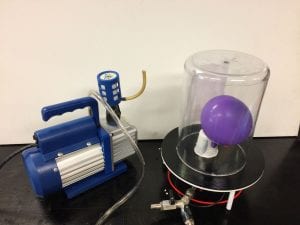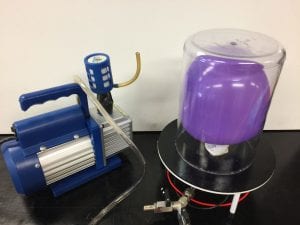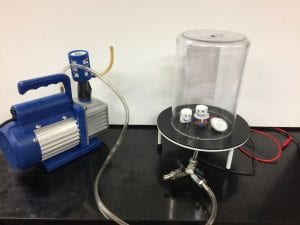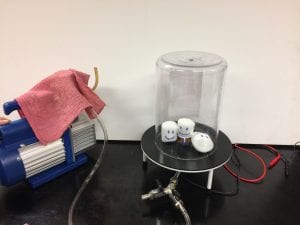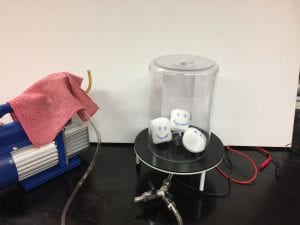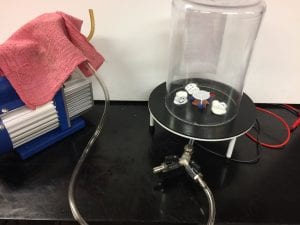This demonstration shows the effects of a change in atmospheric pressure.
The latex balloon rests on a stand in a bell-jar. The balloon expands when the air is removed from the jar by a vacuum pump (Figure 1,2).
Marshmallows are placed in a bell-jar. The marshmallows expand when the air is removed from the jar by a vacuum pump (Figure 3-6).
Materials:
- Latex Balloons
- Fresh Marshmallows
- Bell-Jar
- Vacuum Pump
- Video Camera
Demo:
- Before the demonstration, fill the latex balloon with air, and rest it on the stand in the bell-jar(Figure 1), or place marshmallows in the bell-jar (Figure 3).
- Turn on the vacuum pump.
- Turn off the pump when the latex balloon swells to an appropriate size (Figure 3), or when the marshmallows either reach an ideal size (Figure 5) or if the air pockets burst (Figure 6).
- Open the valve on the bell-jar and let the air in.
Explanation:
Latex Balloon
The latex balloon will not float in air, since the latex balloon is only filled with air, and hence, not light enough by Archimedes’ Principle to float. In this case, the latex balloon rests on a stand that is inside of the bell-jar. The latex balloon is tied off, which makes the latex balloon behave as a closed system, and exerts a constant pressure from the inside of the latex balloon in the outward, radial direction.
When the latex balloon is in the bell-jar full of air, the balloon is at equilibrium, since the pressure exerted by the air inside of the balloon is equal to the pressure of the atmosphere that is acting on the outside of the balloon. When the atmosphere (air) inside of the bell-jar is pumped out, the system is no longer in equilibrium, since the atmospheric pressure in the bell-jar is decreasing, while the pressure inside of the latex balloon remains constant. The pressure inside of the latex balloon is greater than the atmospheric pressure, and the latex balloon with start to expand, until it reaches equilibrium.
Marshmallows
Marshmallows have little pockets of air that are trapped inside of them. When the marshmallows is in the bell-jar full of air, the pressure exerted by the air pockets inside of the marshmallows are in equilibrium with the atmospheric pressure inside of the bell-jar, as seen in Figure 3. As the the atmospheric pressure in the bell-jar decreases due to air being sucked out by the vacuum pump, the system is no longer in an equilibrium state, and the pressure coming from the air pockets inside of the marshmallow is greater than the decreasing atmospheric pressure. The pressure of the air pockets cause the marshmallows to expand, which is shown both in Figure 4 and Figure 5. Eventually, the pressure from air pockets will be too great, causing the air pockets to burst. This causes the marshmallows to no longer swell in size, but to actually deflate, which is shown in Figure 6. When air is re-inserted into the system, the marshmallows will remain in their deflated state, since there is a drastically reduced amount of air pockets, which give them their “puffy” appearance.
For more information about this topic, please see the following demo page:
https://ucscphysicsdemo.sites.ucsc.edu/physics-5b6b-demos/harbottle/
Note:
- WATCH OUT for fluid coming from the vacuum pump that is heading to the vacuum chamber. Close the valve, so that the fluid does not enter the vacuum chamber.
- It is recommended that two people are present for this demo, in order to place the foil helium balloon inside of the large bell jar.
- Please give at least a 2 day notice, so that we could get fresh marshmallows (if necessary).
